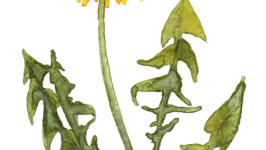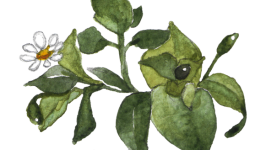Spring Greens, Spring Foods
From lamb’s quarters and chickweed, to cattail shoots and dandelion greens, what’s edible in your backyard this season?
Once upon a time there were no grocery stores where we could purchase year-round greens. And during the cold months we ate foods that we dried, canned, and otherwise preserved so we could survive. Spring was a time to harvest wild plants or grow plants from seeds brought from other lands. There was a connection with the land and the plants that would reinvigorate our “winter” bodies. Today, we call many of these spring foods weeds.
There is a resurgence of interest in greens: these healthy, easily grown plants that are packed with vitamins, minerals, and nutrients. Some may call this a new movement, but, really, it’s a reconnection with traditional or “native” foods.
While deciding which edible greens to write about, I thought about the plants that show up in my garden all on their own. The first edible green that came to mind was chickweed (Stellaria media). This annual makes lots of seeds, a fact that once depressed me. But as an edible and medicinal plant, it is now an asset, not a problem in my garden. What I don’t eat, I pull and leave in the garden as a mulch. I first ate it when it hitched a ride into the kitchen with some lettuce. It has a pleasant taste and texture. And now a disclaimer: I have not eaten all of the edible greens I write about here; it is one of my goals for this season. To make up for my inexperienced palate, I called upon Peter Borchard, owner of Companion Plants in Athens, Ohio, to be my taste expert. One of his favorite wild greens is lamb’s quarters (Chenopodium album). This member of the beet family also goes by pigweed, goosefoot, and other, not-so-complimentary names. The flavor is similar to spinach, beet greens, and Swiss chard, which are all in the same plant family. If you are sensitive to oxalic acid then go slow when tasting this green. In my garden it shows up in compacted, poor soil and the plants are small and scrawny. Last fall I scattered some seeds in better soil and expect that these plants will be filled out, handsome, and tastier. Peter mentioned that the seeds can be ground into flour. I suspect that this would be similar to quinoa flour, also a member of the beet family.
Pokeweed (Phytolaca americana) is a native edible green that must be harvested with caution; when cutting the young shoot (7 inches tall or less) make sure no part of the root is included. I mention it because many references say it is a preferred spring “salat green”—after you boil the shoots in two changes of water. This is one plant I will not taste-test this season. There are also recipes for jelly and pie from the poisonous berries. I think I’ll just leave those for the birds.
A more refined spring green is garden sorrel (Rumex acetosa) and French sorrel (R. scutatus), which are native to the British Isles and Europe respectively. Both have a tart, lemony flavor and are good raw or cooked lightly in sauces or soup. In good soil expect garden sorrel to grow 24–30 inches tall and 24 inches wide. It also grows a deep taproot, which is difficult to remove, so make sure you plant this perennial where you want it. French sorrel is a smaller plant and less cold-hardy than garden sorrel. It is important to plant the correct species: Sheep sorrel (R. acetosella) is used as a medicinal plant, but its oxalic acid content is too high for the leaves to be eaten in any quantity.
Our native cattail (Typha latifolia) is a very useful plant. According to Peter, the new spring shoots and the young rhizomes—harvested from the edges of the cattail colony—are tender and delicious. The cattail fruit has been used to make flour and the leaves can be used for weaving. The accidently introduced European cattail (T. angustifolia) and the hybrid between the American and European species have caused a decline in our native cattail populations. All three are edible, so it’s time for some enterprising chef to declare that cattail shoots and rhizomes are the new native food discovery!
Another wetland edible is the peppery watercress (Nasturtium officinale). One of my references states that it is the “oldest recorded vegetable.” This member of the mustard family is often used on sandwiches, but I enjoy eating it by itself or as a garnish or palate cleanser between courses. A related family member is garden cress (Lepidum sativum), which has a similar spicy flavor. Both are often cultivated in hydroponic growing systems, hence their year-round availability in markets and restaurants.
Another native that shows up on restaurant menus is ramps (Allium tricoccum), also called wild leek, spring onion, ramson, and more. The flavor of the bulbs is delicious and it will stay with you for one or two days after you eat it. For this plant, what’s under the ground is more prized that what’s above. This species will self-seed if it has loamy woodland soils.
I would be remiss if I did not include one of the most important potherbs from Europe and Asia, the much maligned dandelion (Taraxacum officinale). The beneficial aspects and uses of this plant could fill an article in itself. I prefer to eat the young leaves. The older leaves become quite bitter, especially once the plants forms flower buds. The bitterness can dissipate when the leaves are cooked, but truthfully, at that point it’s time to switch to another green. Tea made from the root has a deep coffee-like flavor similar to chicory, and the flowers have been used in wine. One caution: if you harvest your plants from a lawn, make sure that it is free of pesticides.
So winter, the time of hibernation and eating comfort foods, has passed. Embrace spring. Go out, re-engage with nature, and eat some weeds!








